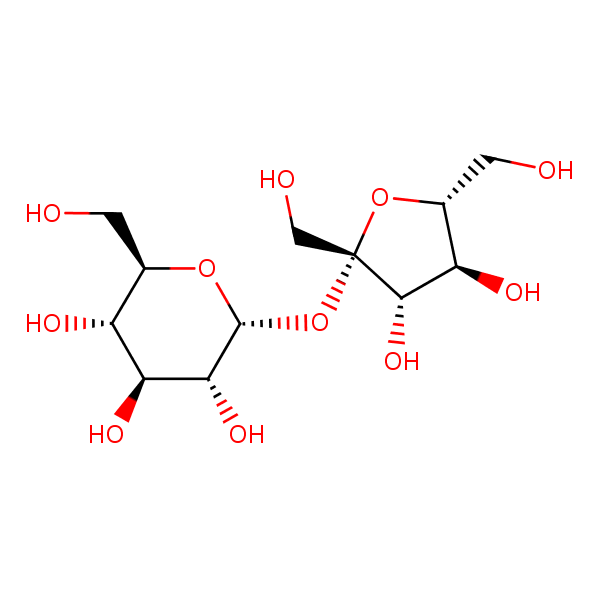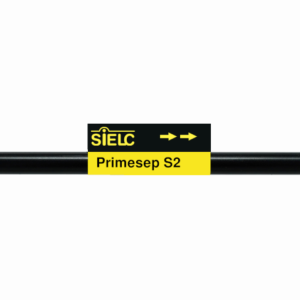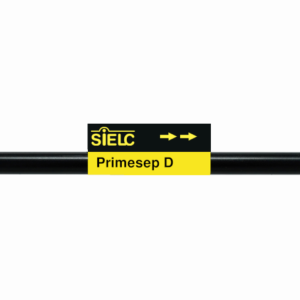| CAS Number | 57-50-1 |
|---|---|
| Molecular Formula | C12H22O11 |
| Molecular Weight | 342.297 |
| InChI Key | CZMRCDWAGMRECN-UGDNZRGBSA-N |
| LogP | -3.70 |
| Synonyms |
|
Applications:
HPLC Separation of Sugars on Primesep S2 Column
July 14, 2011
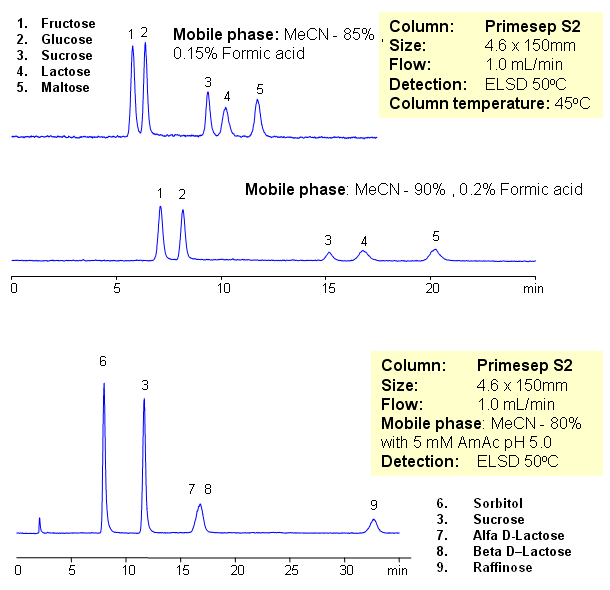
Five sugars were separated on a Primesep S2 HILIC column with LC/MS compatible conditions. Various mobile phase produce different selectivity and separation. Method can be used as alternative to aminopropyl column. Primesep S2 column is stable and does not undergo rapid hydrolysis like aminopropyl columns.
| Column | Primesep S2, 4.6×150 mm, 5 µm, 100A |
| Mobile Phase | MeCN/H2O |
| Buffer | AmAc pH 5.0, Formic Acid |
| Flow Rate | 1.0 ml/min |
| Detection | ELSD 50C |
| Class of Compounds |
Drug, Acid, Monocarboxylic acid, Hydrophilic, Ionizable, Hormone |
| Analyzing Compounds | Fructose, Glucose, Sucrose, Lactose, Maltose, Sorbitol, Sucrose, Alfa D-Lactose, Beta D–Lactose, Raffinose |
Application Column
Primesep S2
The Primesep family of mixed-mode columns offers a wide variety of stationary phases, boasting unprecedented selectivity in the separation of a broad array of chemical compounds across multiple applications. Corresponding Primesep guard columns, available with all stationary phases, do not require holders. SIELC provides a method development service available to all customers. Inquire about our specially-tailored custom LC-phases for specific separations.
Select optionsGlucose
Lactose
Maltose
Raffinose
Sorbitol
Sucrose
alpha-D-Lactose
beta-D-Lactose

HPLC Separation of Barium Cation in the Presence of Citric Acid, Sucrose and Tween 80
July 8, 2011
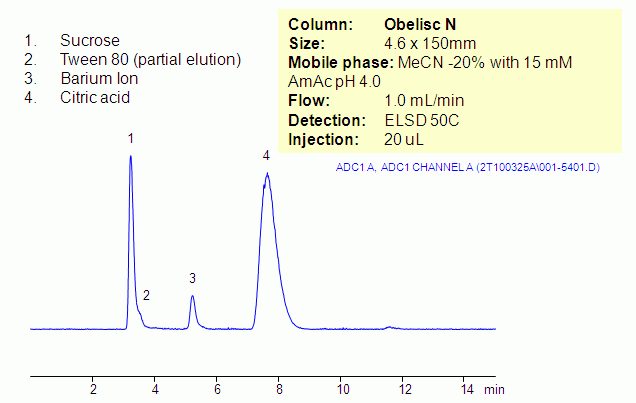
Barium ion and citric acid are analyzed in the presence of sucrose and Tween 80 on Obelisc N HILIC mixed-mode column. Both compounds are retained in ion-exchange mode and HILIC is not employed with this method. Obelisc N HPLC column has basic and acidic ion-exchange groups separated by long hydrophilic chain. Presence of that long chain allows both cation- and anion-exchange mechanisms to exist simultaneously. Obelisc N column can be used for analysis of cation and anions in HILIC/ion-exchange mode and in ion-exchange mode. Analytes can be monitored by ELSD/CAD and LC/MS.
| Column | Obelisc N, 4.6×150 mm, 5 µm, 100A |
| Mobile Phase | MeCN |
| Buffer | AmAc pH 4.0 |
| Flow Rate | 1.0 ml/min |
| Detection | ELSD |
<
| Class of Compounds |
Acid, Ion, Hydrophobic, Ionizable |
| Analyzing Compounds | Barium ion, Citric acid, Sucrose, Tween 80 |
Application Column
Obelisc N
SIELC has developed the Obelisc™ columns, which are mixed-mode and utilize Liquid Separation Cell technology (LiSC™). These cost-effective columns are the first of their kind to be commercially available and can replace multiple HPLC columns, including reversed-phase (RP), AQ-type reversed-phase, polar-embedded group RP columns, normal-phase, cation-exchange, anion-exchange, ion-exclusion, and HILIC (Hydrophilic Interaction Liquid Chromatography) columns. By controlling just three orthogonal method parameters - buffer concentration, buffer pH, and organic modifier concentration - users can adjust the column properties with pinpoint precision to separate complex mixtures.
Select optionsSucrose
Tween 80

HILIC Separation of Sugars on Obelisc N
March 3, 2010
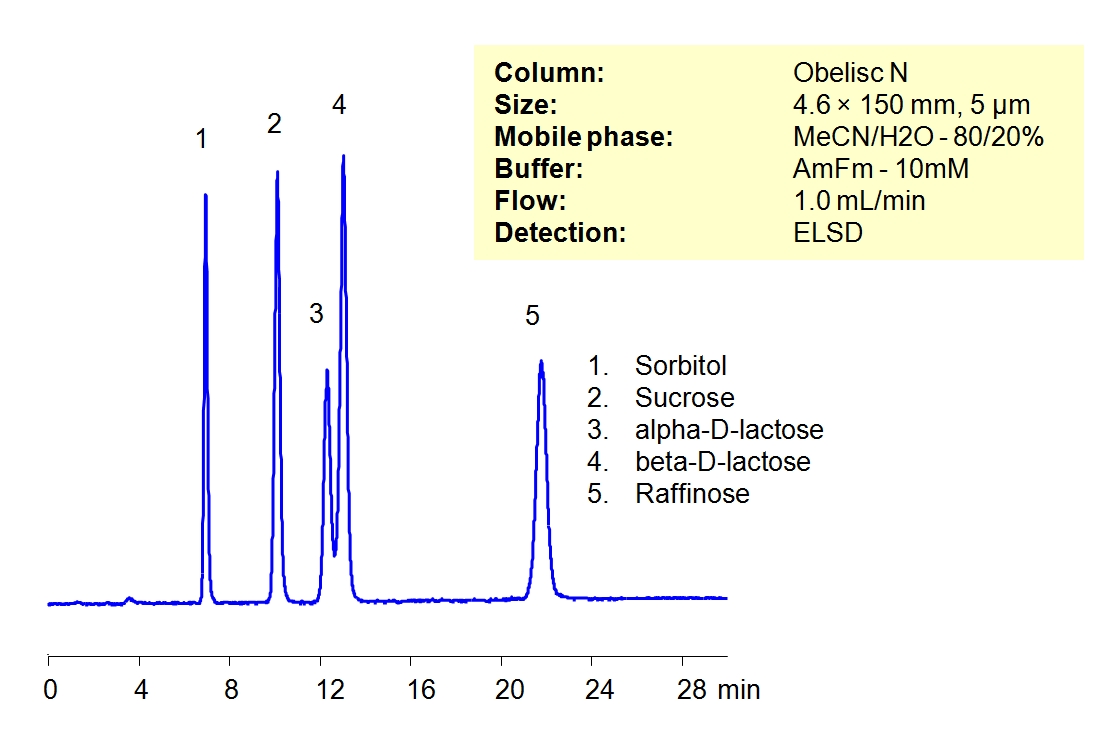
Common sugars can be separated on an Obelisc N HILIC/cation-exchange column with LC/MS compatible mobile phase. Highly polar surface of Obelisc N column provides good retention for sorbitol, sucrose, lactose and raffinose. Other sugars can be separated using this column.
| Column | Obelisc N, 4.6×150 mm, 5 µm, 100A |
| Mobile Phase | MeCN/H2O |
| Buffer | AmFm |
| Flow Rate | 1.0 ml/min |
| Detection | ELSD |
| Class of Compounds |
Hydrophilic, Ionizable, Sugars |
| Analyzing Compounds | Sorbitol, Sucrose, Lactose, Raffinose |
Application Column
Obelisc N
SIELC has developed the Obelisc™ columns, which are mixed-mode and utilize Liquid Separation Cell technology (LiSC™). These cost-effective columns are the first of their kind to be commercially available and can replace multiple HPLC columns, including reversed-phase (RP), AQ-type reversed-phase, polar-embedded group RP columns, normal-phase, cation-exchange, anion-exchange, ion-exclusion, and HILIC (Hydrophilic Interaction Liquid Chromatography) columns. By controlling just three orthogonal method parameters - buffer concentration, buffer pH, and organic modifier concentration - users can adjust the column properties with pinpoint precision to separate complex mixtures.
Select optionsSorbitol
Sucrose
alpha-D-Lactose
beta-D-Lactose

Effect of Both pH and Organic Content on a Separation of Sugars, Amino Acids, and Carboxylic Acids
March 3, 2010
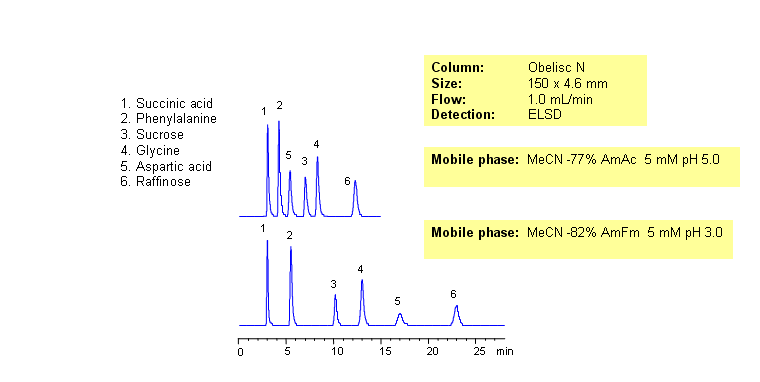
In mixed-mode HILIC chromatography, selectivity of separation can be adjusted by amount of acetonitrile, amount of buffer and buffer pH. Buffer concentration and pH will affect retention of ionizable compounds to a different degree. Retention of neutral compounds can be adjusted by the amount of acetonitrile. Carboxylic acid, three amino acids and two sugars are separated by combination of HILIC and ion-exchange mechanisms. Compounds can be monitored by ELSD, Corona (CAD), LC/MS or low UV. UV-transparent mobile phase /buffer is required for UV monitoring of this mixed-mode separation. This HPLC method can be adopted as general approach for analysis of sugars, amino acids and carboxylic acids.
| Column | Obelisc N, 4.6×150 mm, 5 µm, 100A |
| Mobile Phase | MeCN/H2O |
| Buffer | AmAc |
| Flow Rate | 1.0 ml/min |
| Detection | ELSD |
| Class of Compounds |
Drug, Acid, Hydrophilic, Ionizable, Vitamin, Supplements, Amino acid |
| Analyzing Compounds | Succinic Acid, Phenylalanine, Sucrose, Glycine, Aspartic Acid, Raffinose |
Application Column
Obelisc N
Column Diameter: 4.6 mm
Column Length: 150 mm
Particle Size: 5 µm
Pore Size: 100 A
Phenylalanine
Raffinose
Succinic Acid
Sucrose

HPLC Analysis of Polysorbate in Mixture with Amino Acids and Sugar
July 16, 2009
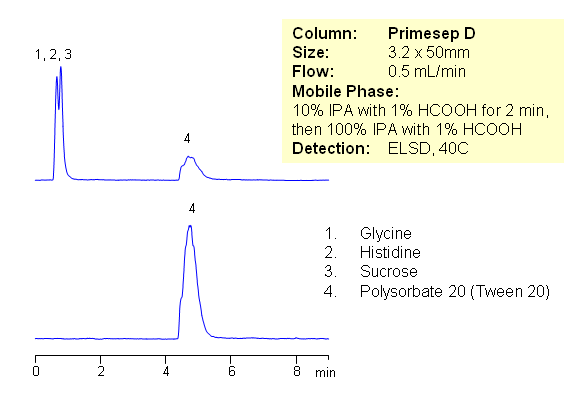
Polysorbates are a class of emulsifiers used in some pharmaceuticals and food preparation. They are often used in cosmetics to solubilize essential oils into water-based products. Polysorbates are oily liquids derived from PEG-ylated sorbitan (a derivative of sorbitol) esterified with fatty acids. Surfactants that are esters of plain (non-PEG-ylated) sorbitan with fatty acids are usually referred to by the name Span. It is often required to quantitate Polysorbate (Polysorbate/Tween 20, Polysorbate/Tween 40, Polysorbate 60/Tween 60 and Polysorbate 80) by HPLC in various formulations. Polysorbates exist in form of oligomers.
| Column | Primesep D, 3.2×50 mm, 5 µm, 100A |
| Mobile Phase | IPA |
| Buffer | Formic Acid |
| Flow Rate | 0.5 ml/min |
| Detection | ELSD |
| Class of Compounds |
Drug, Acid, Hydrophilic, Ionizable, Vitamin, Supplements, Amino acid |
| Analyzing Compounds | Glycine, Histidine, Sucrose, Polysorbate 20 |
Application Column
Primesep D
The Primesep family of mixed-mode columns offers a wide variety of stationary phases, boasting unprecedented selectivity in the separation of a broad array of chemical compounds across multiple applications. Corresponding Primesep guard columns, available with all stationary phases, do not require holders. SIELC provides a method development service available to all customers. Inquire about our specially-tailored custom LC-phases for specific separations.
Select optionsGlycine
Histidine
Polysorbate
Polysorbate 20
Polysorbate 80
Sucrose
Tween 20
Tween 80

